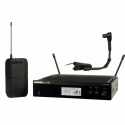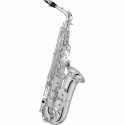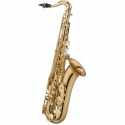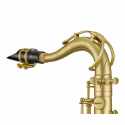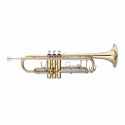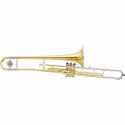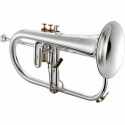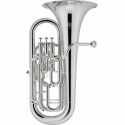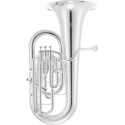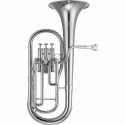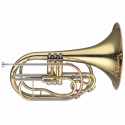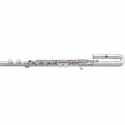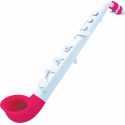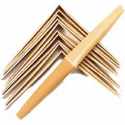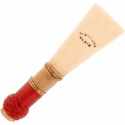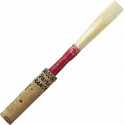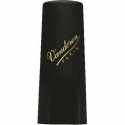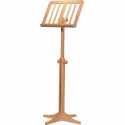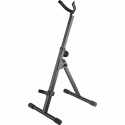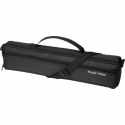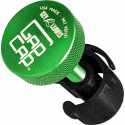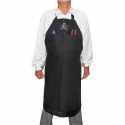WIND INSTRUMENTS
- Alto Saxophones
- Bags for Wind Instruments
- Baritone Saxophones
- Bassoon Reeds
- Care & Maintenance
- Clarinet Mouthpieces
- Clarinet Reeds
- Clarinets
- Euphoniums
- Flugelhorns
- Flute Head and Legs
- Flutes
- Fuerst Pless Horns
- Horn Reeds
- Horns
- Marching Instruments
- Mouthpieces For Brass Instruments
- Mouthpieces Protectors
- Music Stands
- Mutes
- Oboe Reeds
- Polymer wind instruments
- Replacement Parts
- Saxhorns
- Saxophone Mouthpieces Ligatures and Caps
- Saxophone Necks
- Saxophone Reeds
- Soprano Saxophones
- Sousaphones
- Straps for Brass
- Supports for Wind Instruments
- Tenor-Saxophones
- Trombones
- Trumpets and Cornets
- Tubas
- Various Wind Accessories
- Wireless Microphone Systems for Wind Instruments
New products
-

-

STAGG SAC030MPSMPSB Stereo audio cable, mini jack/mini jack (m/m), 30 cm (1')
- Type: Audio cable- Connectors: Mini jack male / mini jack male-...
2,80 € -

STAGG COMMANDOR 10-2 16-fixture DMX light controller with 14 channels per fixture
- Protocol: DMX512 / RDM- Channels: 224 (14 per fixture)- Fixtures: 16,...
271,00 € -

-

-

WIND INSTRUMENTS There are 773 products.
Subcategories
Wireless Microphone...
Welcome to the Wireless Microphone Systems for Wind Instruments category on the MusicGoodDeal e-commerce site, your one-stop shop for all your music equipment needs.
Whether you're a jazz saxophonist, a classical flautist or a passionate horn player, we have the perfect wireless microphone system to help you improve your sound and unleash your creativity. We offer a diverse range of high-end wireless microphone systems, designed specifically for wind instruments, to ensure clarity of sound and freedom of movement on stage.
Our products are carefully selected from the most respected brands in the industry, such as Shure, Sennheiser, AKG and Audio-Technica, guaranteeing quality and reliability. Each wireless microphone system is designed to capture the distinctive sound of your wind instrument, while resisting external interference and offering exceptional range for a smooth performance.
Browse our collection to find the system that matches your playing style and specific needs. Whether you need a rugged system for touring, a compact set for smaller venues, or a high-quality device for studio recordings, MusicGoodDeal has what you need.
And don't forget, our team of experts is always on hand to help you make the right choice. We're passionate about music and dedicated to helping you get the best sound possible. Take advantage of our unbeatable offers and unparalleled customer service when you shop at MusicGoodDeal.
Welcome to the world of superior sound with wireless microphone systems for wind instruments at MusicGoodDeal!
Mouthpieces For Brass...
Welcome to our category dedicated to mouthpieces for wind instruments on MusicGoodDeal, your reference e-commerce site in the world of music.
Our range of mouthpieces is carefully selected to meet all your needs, whether you're a beginner looking for your first accessory or a professional musician in search of a specific sound. We offer a variety of mouthpieces for trumpets, saxophones, clarinets, trombones and many other wind instruments.
Each mouthpiece has been precision-engineered to optimize comfort, control and, of course, sound quality. Our products come from the most respected brands in the music industry, guaranteeing excellent build quality and exceptional durability.
At MusicGoodDeal, we're committed to helping you find the perfect mouthpiece. Our ratings and reviews section lets you hear directly from musicians like you, sharing their experiences with our products. What's more, our team of experts is always on hand to answer your questions and guide you in your choice.
We believe that the right mouthpiece can make a big difference to your musical performance. That's why we've gone to great lengths to offer you the best possible choice. Explore our range of mouthpieces for wind instruments and discover how we can enrich your music with MusicGoodDeal.
Saxophone Mouthpieces...
Welcome to the "Saxophone Mouthpieces and Ligatures" category on the MusicGoodDeal e-commerce site, your one-stop store for all your musical needs. This category is specially designed for saxophonists of all levels, from beginners to professional concert artists.
Here you'll find a complete range of high-quality mouthpieces and ligatures for saxophones. We know that these small accessories can greatly affect the quality of sound produced by your instrument, which is why we've selected products from the most reputable brands on the market, ensuring excellent intonation, ease of play and exceptional sound.
Our saxophone mouthpieces are available in a variety of styles, sizes and materials, to suit every player. Whether you prefer the rich, warm sound of a hard-rubber, or the bright, powerful sound of metal, we have the mouthpiece to suit your needs.
As for our ligatures, we offer options for every type of mouthpiece. A quality ligature is essential for perfect resonance and precise articulation. Whether you're looking for a metal, leather or synthetic ligature, you're sure to find what you're looking for.
At MusicGoodDeal, we're committed to helping you reach your full musical potential. Browse our selection of saxophone mouthpieces and ligatures, and be inspired by the variety and quality of our products. With MusicGoodDeal, your music has never sounded so good!
Clarinet Mouthpieces
Welcome to the Clarinet Mouthpieces & Ligatures category on the e-commerce site of MusicGoodDeal, your online music store of choice.Browse our extensive selection of clarinet mouthpieces and ligatures, designed to deliver exceptional performance and precise tone. Each product we offer is specially selected for its excellent quality and precision engineering, ensuring you always play at your best.
Our clarinet mouthpieces are available in a variety of materials, sizes and styles, suitable for all types of player - from beginner to professional. Each mouthpiece offers clear articulation, precise sound control and unrivalled playability.
Accompany your clarinet mouthpiece with a matching ligature. Our ligatures are designed to ensure even pressure on the reed for optimum resonance. They are easy to adjust, durable and available in a range of styles to suit your personal preferences.
Whether you're looking for rich, full sound for jazz, brilliant projection for orchestra, or simply an upgrade to your current equipment, you'll find what you need here at MusicGoodDeal. Take advantage of our attractive offers, simple and secure purchasing process, and dedicated customer service. Experience the MusicGoodDeal difference today!
Mutes
Welcome to the wind instrument mutes category of MusicGoodDeal, your online destination for all your musical needs. Whether you're a passionate professional or a budding musician, our selection of mutes is designed to meet all your expectations and enhance your musical experience.
We understand the importance of finding the perfect mute for your wind instrument. That's why we've put together a comprehensive range of high-quality mutes, suitable for a variety of instruments including trumpet, trombone, cornet, saxophone, clarinet and many more.
Explore our diverse collection to discover mutes made by the most reputable brands in the music industry. Each mute has been carefully selected for its excellent sound quality, durability and ease of use.
Whether you're looking for a metal, rubber, wood or plastic mute, we've got you covered. Metal mutes offer exceptional sound projection and incomparable clarity, while rubber or wood mutes can produce softer, warmer tones. Plastic mutes are ideal for beginners or those looking for more affordable options without compromising quality.
To make your search easier, our site offers filters and sorting options to enable you to quickly find the ideal mute for your specific needs. You can also consult customer reviews for additional information on each product.
At MusicGoodDeal, we're committed to providing an exceptional online shopping experience. We guarantee competitive prices, fast delivery and responsive customer service. We want to help you find the perfect mute that will enhance your musical playing and allow you to fully express your talent.
Explore our wind instrument mutes category today and discover quality products that will help you reach new musical heights. Trust MusicGoodDeal with your mute needs, and let us accompany you on your musical journey.
Alto Saxophones
Welcome to our section dedicated to Altos Saxophones on MusicGoodDeal, your reference for all things musical! This category brings together an impressive assortment of viola saxophones carefully selected to satisfy all tastes and skill levels.
Beginners will find a range of affordable instruments ideal for starting their musical journey, while more advanced musicians can explore our selection of professional-quality altos. We offer renowned brands such as Yamaha, Selmer and Yanagisawa, which are known for their excellent sound quality, durability and precision construction.
All the viola saxophones featured on MusicGoodDeal are chosen for their rich sound and excellent playability, guaranteeing you a superior musical experience. In addition to instruments, we offer a full range of saxophone accessories, including cases, stands, reeds, straps and much more.
MusicGoodDeal is committed to providing our customers with the best possible service, offering fast delivery, excellent after-sales service and expert advice from our team of music-loving professionals. You can buy with confidence, knowing that every saxophone is carefully inspected and adjusted before shipping to ensure optimum performance from the moment you receive it.
Whether you're a beginning student, an experienced jazz musician or a concert soloist, we're confident you'll find the perfect alto saxophone for you in our selection. Explore our collection today and let the music begin!
Tenor-Saxophones
Welcome to our Tenor Saxophones category on the MusicGoodDeal website! We are proud to present a rich and diverse range of tenor saxophones, suitable for every musician - from the passionate beginner to the professional performer.
Each saxophone in our collection is carefully selected for its sound quality, durability and design. Our tenor saxophones offer a rich, powerful sound, ideal for jazz, blues, pop and more. With instruments from renowned brands such as Selmer, Yamaha, Yanagisawa and Keilwerth, you're sure to find the perfect tenor saxophone for you.
Whether you're looking for a vintage tenor saxophone with a warm, velvety tone, or a contemporary model with a bright, punchy sound, our range of products will meet your needs. And with our team of musical experts on hand to answer your questions and guide you through your purchase, we're sure you'll find the instrument that matches your expectations and musical style.
In addition to our tenor saxophones, we offer a variety of accessories, including protective cases, stands, reeds, and cleaning kits to ensure the longevity of your instrument.
Discover the expressive power and timeless beauty of the tenor saxophone with MusicGoodDeal. Browse our selection today and discover why we're musicians' first choice for their musical instrument needs.
Soprano Saxophones
Welcome to the Soprano Saxophones category of MusicGoodDeal, your online music store.Here you'll discover a wide selection of high-quality soprano saxophones, designed for musicians of all levels. Whether you're a beginner looking for your first instrument, an intermediate musician ready to upgrade, or a professional demanding the crème de la crème, we've got what you need.
Browse our assortment of soprano saxophones, carefully chosen for their exceptional sound, durability and playability. We offer instruments from top brands such as Yamaha, Selmer and Jupiter, as well as emerging brands offering excellent value for money.
In addition to saxophones, you'll also find a full range of essential accessories such as carrying cases, reeds, ligatures and cleaning kits, to ensure that your instrument remains in perfect condition for many years to come.
At MusicGoodDeal, we're passionate about music and committed to providing you with the best possible equipment to help you realize your musical potential. Our experts are always on hand to help you make the best choice. Buy with confidence with our satisfaction guarantee and enjoy our fast, secure delivery.
Immerse yourself in the fascinating world of the soprano saxophone with MusicGoodDeal.
Baritone Saxophones
Welcome to our dedicated Baritone Saxophones section on the MusicGoodDeal website, your store of choice for all your musical instrument needs. Here we offer an exquisite selection of high-quality baritone saxophones suitable for musicians of all levels - from ambitious beginners to accomplished professionals.Our baritone saxophones are chosen for their rich sound and exceptional build quality. Whether you're looking for a smooth, melodious sound for a jazz ensemble or a powerful, robust tone for a solo, you'll find it here. We offer a range of instruments from the industry's most respected brands, including Yamaha, Selmer, Jupiter and many more.
Browsing our collection is like visiting a gallery of masterpieces of craftsmanship. Each baritone saxophone is meticulously finished, aesthetically pleasing and ergonomically well thought-out. From rose gold to antique brass, you can choose the material and finish to suit your personal style.
In addition to the saxophones themselves, we also offer a full range of accessories, including carrying cases, stands, reeds, ligatures and cleaning kits. At MusicGoodDeal, we have everything you need to keep your baritone saxophone in top condition.
We're committed to providing our customers with an exceptional shopping experience. With detailed product descriptions, high-quality photos, flexible delivery options and a dedicated customer service team, buying your next baritone saxophone from MusicGoodDeal will be an experience as melodious as the instrument itself.
So feel free to browse our collection, listen to the music of your heart and find the baritone saxophone that will be your next partner on your musical journey.
Saxophone Necks
Immerse yourself in a world of acoustic refinement, where every note resonates with exceptional clarity and unrivalled expressiveness. Our collection of saxophone jars is meticulously selected to offer musicians of all levels a diverse range of choices, each designed to bring a distinct nuance to your playing.
Each jar you'll find here is the fruit of expert craftsmanship and decades of research into musical acoustics. Whether you're a professional saxophonist looking for the masterpiece for your instrument of choice, or an enthusiastic student in search of new sonic nuances, our collection will meet your most demanding needs.
Why choose our saxophone jars? Because we believe in combining tradition and innovation. Each jar embodies the very essence of proven techniques, while incorporating modern innovations to push the limits of performance. Let yourself be seduced by superior materials, meticulous finishing and attention to detail that translate into unrivalled sound response.
Browse our comprehensive range to find the jar that perfectly matches your musical style, whether it's suave jazz, classical melodies or contemporary experimentation. Our team of music enthusiasts is always on hand to answer your questions and guide you in your choice.
At MusicGoodDeal, we believe that sound quality defines the musical experience, and our saxophone jars are designed to transcend expectations. Explore our exceptional collection today and give your music a new dimension in sound.
Trumpets and Cornets
Welcome to our Trumpets and Cornets category at MusicGoodDeal. Our mission is to make your passion for music resonate. Here you'll discover an exquisite selection of trumpets and cornets, carefully chosen to satisfy musicians of all levels - from beginner to professional expert.
Our trumpets and cornets are sourced from the most renowned manufacturers in the music industry. We offer brands such as Yamaha, Bach, Conn, and King, guaranteeing high-quality sound, exceptional playability and unrivalled durability. Our instruments are available in a variety of finishes, from traditional lacquers to silver or gold, to suit all aesthetic tastes.
At MusicGoodDeal, we understand that every musician has specific needs. That's why we offer models to suit every style of music, whether jazz, classical, pop, rock or brass band. What's more, for budding young musicians, we offer a range of smaller trumpets and cornets, designed to make them easier to hold and learn.
To complete your purchase, don't forget to browse our selection of accessories: carrying cases, mutes, stands, valve oils, and more. You'll find everything you need to maintain your instrument and optimize your playing.
At MusicGoodDeal, we're committed to providing a secure and convenient online shopping experience. You can count on our team of experts to provide invaluable advice and impeccable customer service. What's more, we offer flexible delivery options to ensure your new instrument arrives safely and securely straight to your door.
Explore MusicGoodDeal's Trumpets & Cornets category today and let the sound of your passion for music take flight.
Trombones
Welcome to our trombone category on MusicGoodDeal! At MusicGoodDeal, the quality of our music is our priority, and that's why we've selected an exceptional range of trombones for you.Whether you're a beginner or an experienced musician, a member of a symphony orchestra or a jazz soloist, we've got the right trombone for you. We offer instruments from all the world's top brands, such as Yamaha, Bach and Conn, in all keys (tenor, alto, bass).
Our trombones are available in a variety of materials, from brass to copper-silver, to offer you a diverse palette of sounds to suit your musical style. We also offer a wide selection of accessories, such as mouthpieces, cases, mutes and learning methods to help you optimize your musical experience.
MusicGoodDeal is committed to providing you with first-class customer service. Our experts are on hand to help you choose the trombone that best suits your playing style, budget and musical ambitions. What's more, we make sure your instrument arrives safely on your doorstep, thanks to carefully designed transport packaging.
Discover our collection of trombones and find the instrument that best expresses your musical talent. With MusicGoodDeal, the art of music is at your fingertips!
Fuerst Pless Horns
Welcome to the Hunting Horns category of MusicGoodDeal, your premier destination for all your musical needs. As a leading music store, we are committed to providing our customers with a variety of quality products.
The hunting horn is a historic wind instrument with a rich tradition of playing in hunting music, ceremonies and even classical orchestras. Whether you're a novice musician looking to discover the joys of playing the hunting horn, or a professional looking for a new instrument, we've got something for you.
Our selection of hunting horns includes models from a variety of well-known brands, carefully selected for their sound quality, durability and beauty. Whether you're looking for an affordable entry-level model, a quality intermediate instrument, or a top-of-the-range professional hunting horn, we've got something for you.
We also offer a variety of hunting horn accessories, including carrying cases, stands, learning methods and maintenance products. Our goal is to offer you a complete shopping experience, where you can find everything you need in one place.
Every hunting horn in our store has been carefully inspected and tested to ensure its quality and perfect working order. What's more, our experienced music advisors are on hand to help you make the right choice and answer any questions you may have.
MusicGoodDeal is dedicated to helping you realize your musical dreams. Browse our collection of hunting horns and discover the pleasure of music today!
Flugelhorns
Welcome to the Flugelhorns page of MusicGoodDeal, your reference for musical instruments and audio equipment.
In this category, you'll find a varied selection of flugelhorns, from entry-level models for beginners to top-quality professional models. Our flugelhorns have been carefully selected from the best brands on the market to guarantee their sound and longevity.
Whether you're a budding musician looking for your first instrument, or a seasoned professional looking for the latest piece for your collection, MusicGoodDeal has something for you. Our flugelhorns are available in a variety of finishes, materials and prices to suit all needs and budgets.
In addition to our flugelhorns, we also offer a full range of accessories, including carrying cases, mutes, stands and learning methods. Our aim is to provide you with everything you need to start playing and perfect your music.
With MusicGoodDeal, you benefit not only from high-quality products, but also from impeccable customer service. Our team of passionate and qualified music advisors is always on hand to help you make the right choice.
Immerse yourself in the fascinating world of the flugelhorn and discover the unique sound and versatility it can bring to your music. Explore our selection of flugelhorns today and find the instrument that's right for you.
MusicGoodDeal, your trusted partner for a musical journey without false notes.
Horns
Welcome to the French Horns category on the MusicGoodDeal website, your one-stop destination for all your musical needs. Here you'll find a rich and diverse collection of French horns, carefully selected for their quality, exceptional sound and world-renowned craftsmanship.
Our French horns are available in a wide range of models and brands, including famous names such as Yamaha, Holton and Conn. Whether you're a novice musician looking for your first instrument, or a discerning professional looking to add a new piece to your collection, we have the instrument to suit your needs.
MusicGoodDeal's French Horn category also includes a wide range of accessories for these instruments, from mouthpieces in different shapes and sizes, to sturdy, elegant cases to protect and transport your horn safely.
The French horn is an instrument rich in history and tradition, and at MusicGoodDeal we're committed to helping you explore these aspects in an authentic and personal way. Our team of passionate professionals is always on hand to advise, guide and answer all your questions, so you can find the perfect instrument to express your art.
At MusicGoodDeal, you'll benefit not only from a top-of-the-range selection of French horns, but also from a safe, easy and fast online shopping experience. Take advantage of our regular offers, fast delivery and superior customer service, to make your purchase a pleasant one.
Dive into the enchanting world of French horns with MusicGoodDeal!
Euphoniums
Welcome to the Euphoniums category of MusicGoodDeal, your ultimate destination for quality musical instruments.
At MusicGoodDeal, we have a wide selection of euphoniums for musicians of all levels. Whether you're a beginner looking for your first instrument, or an experienced musician looking to add to your collection, we have the perfect euphonium for you.
Our range of euphoniums is carefully selected from the world's finest brands, guaranteeing outstanding sound quality and durable construction. Our euphoniums are available in a variety of finishes, materials and prices to suit all budgets and preferences.
We offer not only instruments, but also a wide selection of accessories such as cases, mouthpieces and instrument cleaners, so you can care for your euphonium and optimize its performance.
Buying from MusicGoodDeal is a safe and convenient choice. We offer fast, secure delivery, an easy returns policy and dedicated customer service that's always ready to help. Plus, we've got expert guides and advice to help you choose the instrument that's right for you.
So dive into the world of euphonium at MusicGoodDeal and discover the deep harmony and rich sound this instrument has to offer. Your musical journey is important to us, and we're here to make every note you play even more beautiful.
Tubas
Welcome to the Tubas category of MusicGoodDeal, your ultimate destination for all things tuba. We're proud to offer a diverse selection of high-quality tubas to suit all levels of experience - whether you're a beginner looking for your first instrument, or a professional musician looking for the next addition to your collection.
Our tuba selection encompasses a wide variety of world-renowned brands, as well as lesser-known but highly respected manufacturers, all chosen for their exceptional quality and sound. Whether you're looking for a bass, tenor or contrabass tuba, you're sure to find the perfect instrument to suit your specific needs and musical preferences.
In addition to the tubas themselves, we offer a full range of tuba accessories, including cases, stands, mutes and much more. Our goal is to provide you with everything you need to not only play your instrument, but also maintain and improve it.
At MusicGoodDeal, we're passionate about music and committed to providing our customers with the best instruments and accessories available. Our team of experts is always ready to help you choose the instrument that best suits your musical goals and budget. So feel free to browse our selection and discover the rich world of tubas at MusicGoodDeal.
Saxhorns
Welcome to the Saxhorns category of MusicGoodDeal, your one-stop-shop for all your musical needs. In this section, we're delighted to present our exquisite selection of saxhorns, a unique and versatile member of the brass family. Whether you're a professional musician looking for your next flagship instrument, or a beginner eager to explore new sounds, we've got something for you.Our saxhorns, offering a variety of tones from baritone to bass, are rigorously selected for their sound quality, durability and aesthetic design. They come from the world's most renowned manufacturers, such as Yamaha, Besson, and Jupiter, guaranteeing superior performance for all skill levels.
Not only will you discover a robust catalog of saxhorns, but you'll also find indispensable accessories like mouthpieces, protective cases, music stands and stands, as well as learning methods to perfect your mastery of the instrument. We are committed to helping you realize your musical potential, by offering you a complete range of high-quality products.
Our website is designed to make your shopping experience as easy and enjoyable as possible. You can browse through our collection, compare prices, read customer reviews, and even listen to audio demos to help you make your choice.
MusicGoodDeal is with you every step of the way on your musical journey. Our musical instrument experts are always ready to answer your questions, guide you in choosing the right instrument, or provide maintenance tips for your saxhorn.
Take your time, explore and let yourself be carried away by the beautiful harmony of saxhorns on MusicGoodDeal - the place to be for all music lovers.
Sousaphones
Welcome to MusicGoodDeal's Bassophones page, the corner devoted to lovers of the lowest tones in brass band music. Our selection of bassophones features high-quality instruments, carefully crafted by the world's leading manufacturers to meet every need and skill level.In our range, you'll find models that meet the quality demands of the most accomplished and respected musicians. Each instrument is chosen for its tonality, sound projection, playability and durability. We offer bassophones in a variety of finishes and materials, including silver, brass and plastic, all built to stand the test of time.
Our bassophones offer exceptional sonic richness and depth, providing powerful basses to anchor your brass ensemble. They're perfect for marching band, wind band, jazz and any other genre of music that requires a deep bass touch.
We're committed to helping our customers find the perfect instrument for their needs. If you have any questions, please don't hesitate to contact our team of passionate professionals who are here to help you every step of the way.
Whether you're a professional musician looking for the perfect instrument for your next gig, or a beginner keen to explore the world of music through the soubassophone, MusicGoodDeal has the right instrument for you. Browse our collection of soubassophones and discover the wealth of sounds they have to offer.
Welcome to the wonderful world of bassophones at MusicGoodDeal. The ultimate musical experience awaits you here.
Marching Instruments
Welcome to the Parade Instruments section of MusicGoodDeal, your online store specializing in the sale of top-quality musical instruments.In this category, we offer a careful selection of top-of-the-range marching instruments, designed to captivate audiences at your outdoor performances or commemorative events. Whether you're looking for a bright, resonant marching band drum, a dazzling bugle or a cornet à pistons of incomparable quality, MusicGoodDeal has just what you're looking for.
Our marching band instruments are sourced from world-renowned brands known for their manufacturing and design excellence. Each instrument is carefully crafted to produce a clear, powerful sound that can cut through the noise of the crowd and be heard in even the largest parades.
We also offer accessories for your marching instruments, including straps, cases, drumheads and more. When you buy from MusicGoodDeal, you can be sure of receiving products of exceptional quality that will help you deliver memorable performances at every parade.
MusicGoodDeal is dedicated to providing our customers with a seamless online shopping experience. Our product descriptions are accurate and detailed, and our customer service team is always ready to answer your questions and help you choose the perfect instrument for your next fashion show.
Browse our collection of catwalk instruments today and discover the superior sound and quality MusicGoodDeal has to offer.
Clarinets
Welcome to the Clarinet Instruments page of MusicGoodDeal, your one-stop-shop for all your clarinet needs. Whether you're a beginner looking for your very first instrument, or a professional musician in search of a new top-of-the-range clarinet, we've got you covered.Our selection of clarinet instruments features a variety of internationally renowned brands, from Yamaha to Buffet Crampon, as well as local artisans renowned for their exceptional craftsmanship. All our instruments are carefully selected for their sound quality, durability and tonal accuracy.
From Bb clarinets to bass models, from A to Eb clarinets, we offer a wide range for all musical styles and skill levels. In addition to instruments, you'll also find a selection of essential accessories such as reeds, cases, stands and maintenance products to keep your instrument looking its best.
We also offer first-class customer support to help you find the instrument that's right for you. Our experts are always on hand to answer your questions and advise you on the best choice for your needs and budget.
At MusicGoodDeal, we understand the importance of buying an instrument that perfectly matches your musical aspirations. That's why we're committed to offering you the best choice, the best prices and the best service. Explore our clarinet instrument catalog today and discover your perfect sound.
Flutes
Welcome to MusicGoodDeal's Flute Instruments category, your one-stop destination for finding the perfect instrument to meet your musical needs. We understand your passion for music and share your devotion to offering you an exceptional range of flute instruments.Here you'll find a rich and varied selection of flutes, from recorders for beginners to transverse flutes for advanced and professional musicians. Our products include flutes from various brands renowned for their exceptional quality, rich tone and precise craftsmanship. Whether you're looking for a Yamaha, Pearl, Gemeinhardt or other flute, you're sure to find the ideal instrument here.
But that's not all. We also carry a wide variety of flutes from other musical genres, such as Irish flutes, pan flutes and Native American flutes, to name but a few.
In addition to the wide variety of instruments, you'll also find all the accessories you need for your flute: cases, stands, learning methods, spare parts and much more. We're committed to providing everything you need so you can concentrate on what you love most: playing music.
Our site is designed to make your life easier. Each product is accompanied by a detailed description, high-quality photos and customer reviews to help you make the best possible choice.
At MusicGoodDeal, we believe that music is a precious gift, and we're dedicated to helping you realize your passion. Browse our wide selection of flute instruments and let the music take flight.
Flute Head and Legs
Welcome to the page dedicated to flute heads and feet from MusicGoodDeal, your trusted online store for all your musical needs.Whether you're a beginner or a professional flautist, you'll find a variety of top-quality flute heads and feet here. Each of our pieces is carefully selected to offer excellent intonation, fast response and exceptional sound quality. We're proud to offer a full range of products from leading brands in the music industry, guaranteeing durability and performance.
Flute heads can have a significant impact on the tone and character of your instrument. Whether you're looking for a solid silver flute head for a warm, rich sound, or a gold-plated flute head for a bright, clear tone, we've got you covered.
When it comes to flute legs, we offer options for both student and professional flutes. If you want to customize your instrument and modify its weight, balance, resonance and response, our high-quality flute legs are ideal for this.
At MusicGoodDeal, we're passionate about music and committed to providing our customers with the best possible products and services. We also offer expert advice to help you choose the right piece for your playing style and instrument. Don't hesitate to contact us if you have any questions or need help, and take advantage of our great music deals!
Polymer wind instruments
Welcome to the Polymer Wind Instruments page of our MusicGoodDeal store!
Our selection of polymer wind instruments is specially designed for musicians seeking quality and durability. Unlike traditional wooden instruments, these polymer instruments offer excellent resistance to temperature and humidity variations, while retaining outstanding sound quality.
In this category, you'll find a diverse range of flutes, clarinets, saxophones and more, all made from high-quality polymers. These instruments combine the lightness and strength of polymer with the precision and refinement of modern manufacturing techniques.
Whether you're a beginner looking for your first instrument, an intermediate musician looking to take the next step, or a professional looking for reliability and consistency, our polymer wind instruments will meet your needs.
Browse our selection and be amazed by the richness and diversity of sounds these instruments can produce. Each product is accompanied by a detailed description, as well as opinions from musicians who have tested it, to help you make your choice.
Experience a new dimension of sound with our polymer wind instruments. At MusicGoodDeal, we pride ourselves on providing our customers with the best instruments at competitive prices. Don't hesitate to contact us if you have any questions, our team of experts will be happy to help.
MusicGoodDeal, because every musician deserves the best.
Saxophone Reeds
Welcome to the Saxophone Reeds section of MusicGoodDeal! We are proud to offer you a wide selection of high-quality reeds, specially designed for saxophonists of all levels.
At MusicGoodDeal, we understand that the choice of reed is essential to achieving the perfect sound on your saxophone. That's why we've assembled a comprehensive range of reeds from the music industry's most reputable brands. Whether you're a beginner exploring sound possibilities or a demanding professional looking for the best quality, you'll find the ideal reed to suit your needs.
Our selection includes reeds for all types of saxophone, whether soprano, alto, tenor or baritone. You can choose from different strengths, cuts and materials to find the reed that best suits your playing style and instrument.
We work closely with renowned manufacturers such as Vandoren, Rico, D'Addario, Gonzalez and many others, to guarantee reeds of the highest quality. Whether you prefer traditional reeds or synthetic reeds, at MusicGoodDeal you'll find options to suit all your preferences.
In addition to our extensive selection, we are committed to excellent customer service. Our team of passionate experts is on hand to answer all your questions and guide you in your choice. We understand the importance of finding the perfect reed, and we'll do everything we can to help you achieve the sound you're looking for.
Browse our Saxophone Reeds category now and discover the quality and diversity of our selection. At MusicGoodDeal, we're committed to providing musicians with the best products to help them express themselves fully through their music.
Clarinet Reeds
Welcome to the Clarinet Reeds category of the MusicGoodDeal music store! Whether you're a beginner clarinet player or an experienced musician, we've got everything you need to get the best sound from your instrument.Our reeds are carefully selected by our team of experts, which includes professional musicians and music enthusiasts. We understand the crucial importance of a quality reed for optimum tone and accurate response from your clarinet.
In our wide selection of clarinet reeds, you'll find a range of well-known brands, including Vandoren, Rico, D'Addario, Gonzalez and many others. We also offer different levels of hardness to suit the individual preferences of clarinet players.
Whether you play soprano, alto, bass or contrabass clarinet, we have the right reeds for your instrument. Our reeds are available in a range of strengths, from soft to hard, so you can find the one that best suits your playing style and personal preferences.
In addition to traditional reed reeds, we also offer high-quality synthetic reeds. These synthetic reeds offer great stability, increased longevity and an even response, ideal for musicians looking for a reliable and consistent alternative to reed reeds.
At MusicGoodDeal, we understand the importance of accessibility and diversity in the world of music. That's why we make sure to offer a wide range of prices to meet the needs of all clarinet players, from beginners to professionals.
Browse our selection of clarinet reeds and discover the one that will bring your music to life. Our team is also here to help you and answer any questions you may have, to ensure you make the best choice for your musical practice.
Trust MusicGoodDeal to find the high-quality clarinet reeds you need to reach your full musical potential. We are committed to providing exceptional products and first-class customer service to satisfy all your musical needs.
Horn Reeds
Welcome to the "French Horn Reeds" category of the MusicGoodDeal music store! We're delighted to offer you a wide selection of high-quality reeds specially designed for French horns.
Reeds play an essential role in producing a rich, balanced sound on a French horn. They are responsible for the vibration of the instrument and directly influence sound quality. At MusicGoodDeal, we understand the importance of choosing the right reeds for your instrument, which is why we offer you carefully selected products from the best brands on the market.
Whether you're a beginner or an experienced musician, our "Reeds for French Horns" category offers a wide range of options to suit all needs and musical styles. We work closely with reputable manufacturers who use high-quality materials to guarantee optimum durability and performance.
Browse our collection to discover reeds of different hardness levels, from renowned brands such as Vandoren, Rico, La Voz, Gonzalez and many more. You'll find reeds to suit different types of French horn, whether single, double or natural.
We also understand that every musician has his or her own preferences and sound requirements. That's why we offer a variety of reed cuts and strengths, enabling you to find the perfect combination to express your style and musicality.
At MusicGoodDeal, our goal is to provide you with an exceptional shopping experience. Our team of experts is here to guide you and answer all your questions, from choosing the right reeds to advice on their use and care.
Don't forget to check out our regular special offers and promotions to benefit from the best prices on French horn reeds. We update our inventory regularly to bring you the latest products on the market.
Browse our "French Horn Reeds" category now and find the perfect reeds to enhance your playing and express your musical passion with MusicGoodDeal!
Bassoon Reeds
Welcome to the Bassoon Reeds category of the MusicGoodDeal music store! Whether you're a beginner bassoonist or an experienced musician looking for the best reeds for your instrument, you've come to the right place.We understand the crucial importance of a quality reed for optimal sound and outstanding musical performance. That's why we've put together a carefully chosen selection of bassoon reeds from the most reputable brands in the music industry.
Our range of bassoon reeds includes a variety of strengths, cuts and brands to meet the individual needs of every musician. Whether you prefer single reeds, double reeds or synthetic reeds, we have what you need. We work closely with renowned manufacturers such as Vandoren, Jones, Gonzalez and many others, to offer you superior quality and a wide variety of choices.
At MusicGoodDeal, we also understand that every musician has unique needs and preferences. Our team of experts is here to help you find the perfect reed to suit your playing style, skill level and personal requirements. Whether you're looking for easy-to-play reeds for beginners or professional reeds for seasoned players, we're here to advise you.
In addition to our wide selection of bassoon reeds, we also offer a range of related accessories such as reed guards, reed holders and storage cases, to ensure you have everything you need to care for your equipment.
Order your bassoon reeds now from MusicGoodDeal and discover the difference a quality reed can make to your playing. Take advantage of our easy and secure online ordering process, with fast and reliable delivery straight to your door.
We pride ourselves on providing musicians with high-quality products, exceptional customer service and expert advice. Join MusicGoodDeal's community of satisfied musicians and explore our Bassoon Reeds category today!
Oboe Reeds
Welcome to the "Oboe Reeds" category of the MusicGoodDeal music store! Here you'll find everything you need for your oboe, whether you're an enthusiastic beginner or an experienced player looking for the best sound quality.Our oboe reeds are carefully selected by our experts to guarantee an exceptional musical experience. We offer a variety of well-known brands, renowned for their reliability and exceptional sound, such as Vandoren, Rigotti, Gonzalez and Marca. Whether you prefer traditional French reeds or innovative synthetic options, we've got you covered.
We understand the importance of the right reed for the perfect sound. That's why we offer a wide range of strengths, from very soft to very hard, to suit every musician's individual preferences and needs. Our team of specialists is also on hand to advise you on the choice of reeds best suited to your playing style and requirements.
In addition to oboe reeds, we also offer a selection of essential accessories such as reed holders, protective cases, reed scissors and much more. We strive to offer you a complete shopping experience, where you can find everything you need to maintain and enhance your musical practice.
At MusicGoodDeal, we are committed to providing high-quality products and exceptional customer service. Our user-friendly website allows you to easily browse our oboe reed collection, compare options and place your order with just a few clicks. We also offer fast, reliable delivery so you can start playing straight away.
Explore our "Oboe Reeds" category now and discover a complete range of high-quality reeds to meet all your musical needs. Trust MusicGoodDeal to provide you with an unparalleled playing experience and enhance your oboe sound.
Mouthpieces Protectors
Welcome to the Instrument Mouthguards category on MusicGoodDeal, your one-stop destination for all your musical needs. Here we offer you a wide selection of high-quality mouthguards for all types of wind instruments.
Whether you play saxophone, clarinet, trumpet or other wind instruments, you'll understand how crucial it is to protect the mouthpiece of your instrument. These small parts are essential for producing a clean, clear sound. Without a good mouthguard, comfort and playing quality can be significantly reduced.
In our online store, we offer a variety of mouthguards designed to fit your instruments perfectly. We have mouthguards in different shapes, sizes and materials, from rubber to leather or plastic, to suit your personal preferences and the specific needs of each instrument.
Each mouthguard we offer has been carefully selected for its durability, comfort and ability to enhance the sound quality of your instrument. What's more, we collaborate with the most reputable manufacturers in the industry, guaranteeing you products of the highest quality.
Browse through our collection to discover our diverse offering. Whether you're a beginner looking to make your first purchase, or a professional musician looking for the perfect replacement part, you're sure to find what you need at MusicGoodDeal. We pride ourselves on providing the best mouthguards to ensure your music always sounds its best.
If you have any questions or need assistance, our team of experts is here to help. We are dedicated to helping you make the best choice for your music. Trust MusicGoodDeal to protect your instrument and enhance your musical performance.
Music Stands
Welcome to the Wind Instrument Stands section of MusicGoodDeal, your online reference for all things musical. If you play the flute, clarinet, saxophone or any other wind instrument, you know how essential it is to have a sturdy, reliable music stand for your practice sessions and performances.
Our range of wind instrument stands has been carefully selected to offer the quality and durability you need, whether you're a novice musician or a seasoned professional. Designed for optimum comfort and ease of use, our music stands are adjustable in height and angle, allowing you to customize your playing space to your preferences.
At MusicGoodDeal, we're committed to providing you with only the best products from trusted brands. Our music stands are available in a variety of materials, from lightweight but sturdy metal to noble wood for a touch of sophistication. All are designed to be easily transportable, with folding options for the musician on the move.
Discover our selection of music stands for wind instruments today. Whether you're looking for a music stand for your home rehearsals or for your concerts, we have the product to meet your needs. We also offer a range of accessories, including sheet music clamps, music stand lights and more, to ensure the best possible musical experience.
Take advantage of our easy navigation and detailed product descriptions to find the perfect music stand for your wind instrument. If you need more information, our team of music experts is always on hand to help. Make your music as enjoyable as possible with MusicGoodDeal.
Supports for Wind...
Welcome to our Wind Instrument Stands category at MusicGoodDeal - your online store dedicated to all music enthusiasts. Here you'll find a selection of wind instrument stands carefully chosen to meet your needs for safety, durability and functionality.Designed to protect and enhance your precious wind instruments, our stands are manufactured by world-renowned brands. Whether you're a professional flute player looking for a sturdy stand for your flute, an amateur trumpet player looking for a compact stand to practice on at home, or a saxophone player looking for a stable stand for the stage, you've come to the right place.
Our wind instrument stands are designed to offer exceptional stability and protect your instruments from scratches and accidental drops. Plus, we have specially designed stands for a variety of instruments, including stands for flute, clarinet, trumpet, saxophone and more.
Whether you need a lightweight desktop stand for your practice sessions or a sturdy floor stand for a live performance, MusicGoodDeal is here to help you find the perfect stand for your wind instrument.
Browse our collection and take advantage of our competitive prices, dedicated customer service and fast delivery. We believe that every musician deserves the best, and we're committed to helping you find the right stand for you and your wind instrument.
MusicGoodDeal - more than just a music store, your dedicated partner in your musical journey.
Bags for Wind Instruments
Welcome to the Wind Instrument Covers category on MusicGoodDeal, your trusted online music store.
In this section, you'll find a vast selection of cases and covers specially designed to protect and transport your precious wind instruments. Whether you play flute, clarinet, saxophone, trumpet or any other wind instrument, we've got you covered.
Our covers and cases are carefully selected for their strength, durability and ability to protect your instrument from damage, shock and weather. They are made from high-quality materials to ensure maximum protection, while offering elegant design and practical features such as accessory pockets and adjustable shoulder straps for easy transport.
We offer products from reputable brands in the music industry, ensuring that you receive a case or bag that will not only protect your instrument, but last as long as your passion for music.
Don't wait any longer, browse our collection and give your instrument the care it deserves with a case or cover from MusicGoodDeal.
Straps for Brass
Welcome to the "Wind Instrument Cords & Harnesses" category of MusicGoodDeal, your ultimate destination for all your musical needs.Here, we offer a variety of cords and harnesses specially designed for wind instruments. Our selection includes options for musicians of all levels, from beginner to professional. Whether you're a flautist looking for a comfortable cord for your long practice sessions, a saxophonist wanting a high-quality harness for better stage performance, or a clarinetist looking to replace an old cord, we have something for everyone.
Our cords and harnesses are sourced from the world's most reputable manufacturers, guaranteeing not only comfort and fit, but also durability and reliability. The high-quality materials used in these products ensure optimum support, while reducing pressure on the neck and shoulders. Musicians can concentrate fully on their music, without worrying about fatigue or discomfort.
We understand that every musician is unique, and that's why our range offers a variety of styles, sizes and colors. You can choose from simple cords, harnesses with back support or more sophisticated models with advanced adjustment options. What's more, we offer options suitable for both children and adults.
Explore MusicGoodDeal's "Wind Instrument Cords & Harnesses" category and discover products that can enhance your musical experience. Our competitive prices and excellent customer service make us your best choice for all your wind instrument accessory needs. Music is our passion, and we're dedicated to providing the best products to support your musical journey. So look no further - your ideal solution awaits you here at MusicGoodDeal.
Replacement Parts
Welcome to the "Spare Parts for Wind Instruments" category of the MusicGoodDeal website. At MusicGoodDeal, we understand the importance of maintaining and constantly improving your wind instrument, so that you can give your best in every performance.
In this section, you'll find an impressive variety of spare parts for all your wind instruments. Whether you play saxophone, trumpet, clarinet, flute, tuba or any other wind instrument, we have everything you need to keep your instrument in top condition.
We have a rich and varied selection that includes mouthpieces, ligatures, mouthpiece covers, reeds, jars, pipes, mouthpieces, pads, springs and much more. All our products are sourced from world-renowned manufacturers renowned for their superior quality and durability.
Our aim at MusicGoodDeal is to make finding and buying spare parts for your wind instrument as easy as possible. Thanks to our easy-to-use filtering options, you can search for exactly what you need by instrument, brand, price and much more.
Whether you're a professional musician looking for high-quality parts for your upcoming tour, or a beginner looking to take care of your new instrument, we have everything you need.
Trust MusicGoodDeal for all your wind instrument parts. Because we know that a good musician is only as good as the condition of his or her instrument. Browse our range now and take the first step towards improving your sound even further.
Care & Maintenance
Welcome to the Wind Instrument Care category of MusicGoodDeal, your one-stop shop for everything to do with maintaining and improving the performance of your favorite wind instruments. We know how essential it is to keep your instruments in top condition, which is why we have carefully selected an assortment of high-quality maintenance products.Here you'll find a diverse range of cleaning kits, valve oils, cork greases, cleaning brushes and other essential tools for a variety of wind instruments - whether you're an amateur clarinetist or a professional trumpeter. Our products are suitable for all types of instrument, from French horn to flute, saxophone to trombone, and many more.
Each product is accompanied by a detailed description, advice on use and often reviews from other musicians who have already used these products. What's more, you can rely on the quality of our maintenance products. We only partner with trusted brands that are committed to providing reliable and effective products to ensure the best possible care for your instrument.
At MusicGoodDeal, we believe that good care is the key to great sound. So browse our selection and give your wind instrument the attention it deserves. You'll be amazed at how a little maintenance can make a big difference to your musical performance.
Various Wind Accessories
Welcome to our Miscellaneous Wind Instrument Accessories category at MusicGoodDeal, your one-stop shop for all your wind instrument accessory needs. At MusicGoodDeal, we understand the importance of every part and accessory in producing the perfect sound.In this category, you'll find a carefully curated selection of various accessories for your precious wind instruments. From maintenance to performance, we've thought of everything. Our catalog includes mouthpieces, ligatures, covers, cases, cork grease, cleaning pads and much more. Each product has been selected with an eye to its usefulness for musicians of all levels, from beginners to professionals.
Our aim is to help you protect, maintain and improve your instrument so you can continue to create beautiful music. Each product is accompanied by a detailed description to help you make the best choice.
We work with leading brands in the music industry to bring you top-quality products at competitive prices. If you need help choosing the perfect accessory, our team of music experts will be delighted to help.
Enjoy browsing our vast selection of various wind instrument accessories at MusicGoodDeal. Your musical satisfaction is our greatest reward.
HERCULES ORCHESTRA MUSIC STAND BS408B-PLUS
Hercules BS408-PLUS bandstand
Reduced price!In Stock119,00 € 119,90 € -0.7506%VANDOREN C59P Baritone m-o plastic
Baritone m-o plastic
Reduced price!On order only7,50 € 8,30 € -9.6386%VANDOREN CR124 Bass box of 5 reeds - Force 4
Bass Box of 5 Reeds - Force 4 These are the most played reeds in the...
Reduced price!In Stock27,00 € 29,60 € -8.7838%DENIS WICK 58824 Classic - Silver 4
Classic - Silver 4
Reduced price!On order only86,00 € 87,80 € -2.0501%BG ASGP9 Screws for metal and Flex...
Screws for metal and Flex ligatures - rose gold plated
Reduced price!In Stock6,70 € 14,00 € -52.1429%PEARL FLUTE TFC2R Dolce & Elegante wood C...
Dolce & Elegante wood C foot
Reduced price!On order only275,00 € 333,00 € -17.4174%4X 68.75€ No charges !PEARL FLUTE PFA201U Silver plated nickel...
Silver plated nickel silver head and tube - Alto flute with curved head PFA201U
Reduced price!On order only2 327,00 € 2 450,00 €PEARL FLUTE PFP165ES Grenadilla - Smooth head
Grenadilla - Smooth head
Reduced price!On order only1 705,00 € 1 895,00 € -10.0264%PEARL FLUTE PFP105E Grenadite - Mustache head
Grenadite - Mustache head
Reduced price!On order only1 259,00 € 1 449,00 € -13.1125%4X 314.75€ No charges !PEARL FLUTE PFP105ES-OM Grenadite - Smooth...
Grenadite - Smooth head
Reduced price!On order only1 433,00 € 1 593,00 € -10.0439%4X 358.25€ No charges !GETZEN 900 Bb - Lacquered brass
Bb - Varnished brass
Reduced price!Stock expected from 06/12/20244 119,00 € 4 577,00 € -10.0066%SML PARIS 521N Miscellaneous - Bass Clarinet
Miscellaneous - Bass clarinet
Reduced price!This product is discontinued6,30 € 14,45 € -56.4014%
Welcome to the wind instruments category on MusicGoodDeal!
Enjoy an incomparable musical experience with our impressive selection of wind instruments. MusicGoodDeal, your destination of choice for all your musical instrument needs, offers a wide range of top-quality wind instruments, from flutes to clarinets, trumpets to saxophones and much more.
Our catalog includes a wide variety of instruments to satisfy enthusiastic beginners as well as the most demanding professional musicians. Each instrument is carefully selected for its sound quality, durability and ease of use. Whether you're looking for a new instrument to develop your skills or a replacement for your current one, you're sure to find what you need here.
We are committed to offering our customers the finest wind instruments available on the market. That's why we work with world-renowned brands such as SML Paris, Antigua, Adagio, Trevor James, Stagg, Jupiter, Carol Brass, XO, Getzen, Pearl flute, and many more, to ensure you get the best the music industry has to offer.
MusicGoodDeal also offers a variety of wind instrument accessories, including cases, stands, reeds, mouthpieces and more. So you can look after your instrument and improve your musical performance.
In addition to our high-quality products, we offer fast, reliable delivery and exceptional customer service to help you make the best possible choice. Our dedicated team of music experts is always ready to answer your questions and guide you through your purchasing journey.
Browse our wind instruments catalog and discover the richness of our offer. With MusicGoodDeal, the instrument of your dreams is just a click away!
